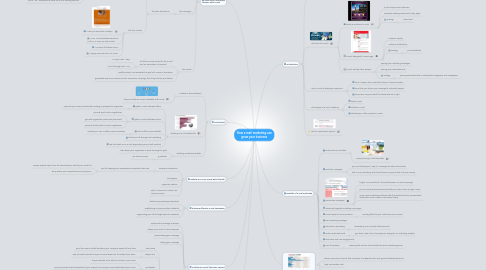
1. Introduction
1.1. What is e-mail marketing?
1.1.1. the use of e-mail in marketing communications
1.2. What sort of e-mail?
1.2.1. direct promotional e-mails
1.2.1.1. try to acquire new customers
1.2.1.2. persuade existing customers to buy again
1.2.1.3. analogy
1.2.1.3.1. direct mail
1.2.2. e-mails designed to encourage
1.2.2.1. customer loyalty
1.2.2.2. customer relationship
1.2.2.3. analogy
1.2.2.3.1. print newsletter
1.2.3. e-mails sent by other people
1.2.3.1. placing your marketing messages
1.2.3.2. placing your advertisements
1.2.3.3. analogy
1.2.3.3.1. placing advertisements in subscription magazines and newspapers
1.3. Why is e-mail marketing so popular?
1.3.1. much cheaper than most other forms of communication
1.3.2. email lets you deliver your message to individual people
1.3.3. has proven very successful for those who do it right
1.4. Three types of e-mail marketing
1.4.1. direct e-mail
1.4.2. retention e-mail
1.4.3. advertising in other people's e-mails
1.5. Ask for a permission (opt-in)
2. Benefits of e-mail marketing
2.1. reduced time and effort
2.1.1. using recurring e-mail templates
2.2. real-time messages
2.2.1. you can literally send "day-of" messages to help reduce stock
2.2.2. with e-mail marketing, short time frames are your friend, not your enemy.
2.3. personalize messages
2.3.1. forget "one-size-fits-all" format (television or radio campaign)
2.3.2. you can send personalized email with your user's name or login name
2.3.3. many email marketing solutions offer the ability to feed in personalized information such as sales or purchase history
2.4. extremely targeted marketing campaigns
2.5. more frequent communications
2.5.1. sending offers to your customers once a week
2.6. test marketing messages
2.7. information spreading
2.7.1. forwarding an e-mail only takes seconds
2.8. reduce overhead costs
2.8.1. you don't need a ton of employees, designers, or marketing analysts
2.9. track sales and user engagement
2.10. save the planet!
2.10.1. reducing the number of trees killed for print marketing pieces
3. Case study: improving revenue with e-mail
3.1. How four emails boosted end of year revenue for a non profit by 50%
3.2. this email marketing case study was originally published in the July 26, 2011 edition of Marketing Sherpa
3.3. HealthConnect One
3.3.1. promotes the health of mothers, infants and families
3.3.2. December is a critical month for donations that will fund the nonprofit organization for the next year
3.4. the campaign
3.4.1. the team focused on
3.4.1.1. keeping it simple
3.4.1.1.1. each e-mail template was simple
3.4.1.2. the four e-mails
3.4.1.2.1. "Have you ever been a baby?"
3.4.1.2.2. "Over 143,000 babies were born in the U.S. since our last e-mail!"
3.4.1.2.3. "We were all babies once!"
3.4.1.2.4. "Happy New Year from HC One!"
3.5. the results
3.5.1. all of the e-mails except for the e-mail sent on December 23 received
3.5.1.1. an open rate > 20%
3.5.1.2. a click through rate > 4%
3.5.2. HealthConnect One exceeded its goal of $15,000 in donations
3.5.3. generated 50% more revenue in their December campaign than they had the year before
4. Get started
4.1. Flashissue (free software)
4.1.1. lets you create an e-mail newsletter with Gmail
4.2. building an e-mail adress file
4.2.1. gather e-mail adresses offline
4.2.1.1. every time you communicate with existing or prospective supporters
4.2.2. gather e-mail addresses online
4.2.2.1. provide quick online registration
4.2.2.2. give site registration prominent placement
4.2.2.3. promote the benefits of online registration
4.2.3. drive traffic to your website
4.2.3.1. include your URL in offline communications
4.2.4. build your list through viral marketing
4.2.5. use list rentals or an e-mail appending service (with caution)
4.3. building constituent profiles
4.3.1. data about your supporters is worth its weight in gold
4.3.2. guidelines
4.3.2.1. use online surveys
5. Making sure your e-mail gets through
5.1. recipients complaints
5.1.1. tips for keeping your organization’s complaint rates low
5.1.1.1. acquire explicit opt-in from all individuals you add to your email list
5.1.1.2. study where your complaints are coming from
5.2. list hygiene
5.3. supporter options
5.4. when It comes to content, use common sense
6. Planning effective e-mail campaigns
6.1. determining campaign objectives
6.2. establishing a communication schedule
6.3. segmenting your list to target specific audiences
7. Crafting an e-mail that gets opened
7.1. optimize the message envelope
7.2. design your email to drive response
7.3. personalizing your message
7.4. testing your message
7.5. e-mail basic tips
7.5.1. from name
7.5.1.1. your from name should be whom your recipients expect to hear from
7.5.2. subject line
7.5.2.1. 50% of readers decide to open an email based on the subject line alone
7.5.3. pre-header
7.5.3.1. the pre-header is the first line of text in your email
7.5.3.2. your pre-header should complement your subject line and give more details about your email
7.5.3.3. you can even link your pre-header to a landing page
7.5.4. header
7.5.4.1. on average, 8 out of 10 people will read headline copy, but only 2 out of 10 will read the rest
7.5.4.2. it’s going to keep your recipient reading
7.5.5. personalization
7.5.6. images
7.5.7. call-to-action (CTA)
7.5.8. social badges
8. Tracking and measuring results
8.1. Helpful benchmarks to evaluate your results
8.1.1. open rate
8.1.2. click-through rate (ctr)
8.1.3. response rate
8.1.4. opt-out (or unsubscribe) rate
8.1.5. forward rate
